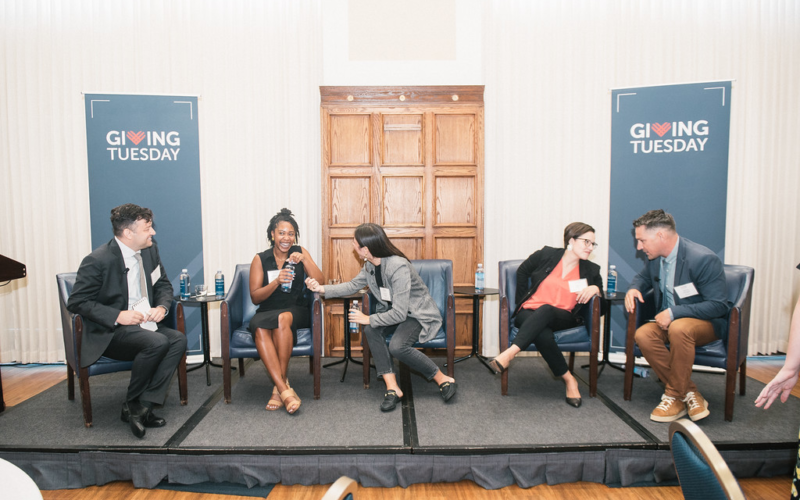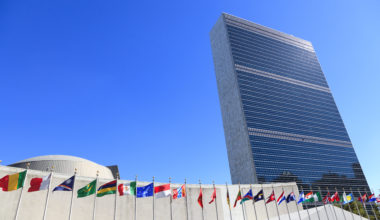This past Tuesday, I saw again the power of the GivingTuesday community. A group of us co-hosted what was called a “share-a-thon” to bring together great ideas and help mark the 90-day countdown to Giving Tuesday 2022. Good people came together, and great ideas came forward.
In a room packed with brilliant and creative change makers, we not only marked the three-month countdown, but the reality that people from all around the globe want to engage in radical generosity.
The convening included people powering Giving Tuesday like Celeste Flores and came together thanks to the vision and kindness of everyone from the National Press Club to Boncom to friends from the Industry Affairs Council. It felt like a family moment, because these people came together to share, not to compete. They came together to build.
David Hessekiel (President of Cause Marketing Forum, Inc.) best summed up the atmosphere when he remarked on the “diversity of causes” represented and how we are all “united in the business of moving people to take action of different types.” The people who gathered for this event truly are the purpose-driven movers and shakers we need to inspire us all to disrupt patterns of injustice, alleviate suffering, and inject compassion and hope into the world.
One of the things I admire most about this community of champions and helpers is that they share as they learn. We will only get to bigger and better solutions to common challenges when we embrace collaboration.
The share-a-thon had two workshops filled with wisdom and inspiration. The first one focused on public engagement and was moderated by Hessekiel (President of Cause Marketing Forum, Inc.). It also included Bidjan Nashat (CEO of Atlas Corps), Emily Hellewell (Director of Communication and Marketing at Boncom), Jeremy Butler (CEO of Iraq and Afghanistan Veterans of America), and Lewis Moon (Director of Corporate Partnerships at No Kid Hungry).
The second workshop explored and examined tactics specific to GivingTuesday, and Nick Massella (Senior Director of Brand Strategy and Communications at PBS News Hour) facilitated a conversation between Cecilia Diem (Managing Consultant at American Philanthropic), Marina Adese (Associate Director of Creative Strategy and Social Media at the International Rescue Committee), Rachael Payton (President and Founder of Be Great DC), and Steve Wright (VP of Client Services at Boncom).
Listening to both the workshop panel discussions and the remarks given by our honorary guests Garry Gilliam (Founder/CEO of The Bridge Eco-Village), Jason Wright (New York Times Best-selling Author), Chris Carlson (VP of Client Strategy at Boncom), and Celeste Flores (US Communities Lead at GivingTuesday), three major themes took hold:
1) Collective but Personal
#GivingTuesday is a global giving movement that activates the ideals of individuals. Celeste Flores stressed that “people shouldn’t feel like ATMs,” and that recipients of GivingTuesday donations should make efforts to ensure their relationship with their supporters is not “transactional” but “transformational.”
Bidjan Nashat touched on this same sentiment when he reflected on his personal experiences contacting his organization’s supporters and having one-to-one interactions with them. He was surprised by how much these interactions meant to the individuals he contacted—their sense of value surged, and they were able to convey to him directly why they cared about his organization. It was beneficial in both directions.
In a time when we see more eye-to-screen and less eye-to-eye, Jason Wright moved us with stories about how he exercises the power of generosity to uplift and humanize others on a highly interpersonal level. He shared with us that “kindness is in the eyes” and how we look at people can profoundly affect them. As we talked about a movement like GivingTuesday that largely deploys the digital to achieve its ends, Jason’s emphasis on the personal touches of giving reminded us not to lose sight of the people we are serving in the dollars and cents we may be donating or raising.
Steve Wright commented that GivingTuesday is a shared story, and we must work “to give everyone a chapter” in this unfolding narrative around generosity. Collaboration is key, and as Jeremy Butler illustrated through a professional anecdote, sometimes the most unexpected partners can help spread your organization’s message in “unexpected and oversized ways.”
Celeste Flores urged the event’s attendees not to view GivingTuesday as a competition, but as a cooperative enterprise founded on the notion that “others’ suffering should be as intolerable as our own.” As she so beautifully articulated, we shouldn’t be jockeying for a bigger slice of the pie, but instead, we must work together and lift fellow organizations “to make the pie bigger.”
The expert voices we heard all pointed to the idea that by affirming the worth of individuals, we foster more cooperation among them. When we illuminate the particular details of a life we are trying to change, we can clearly see the connection to our own lives. GivingTuesday and cause-based initiatives writ large must resonate personally to reverberate collectively.
2) The Enduring Power of Storytelling
Storytelling and its ability to give color and dimension to an organization’s mission took center stage at the event. Story is everything, and as Lewis Moon highlighted, stories “connect people on an individual level to the impact of your organization.” It is through storytelling that your supporters tether themselves to your organization. By authentically illustrating your organization’s influence and impact, you inspire trust in the work and where it will lead.
The dominant medium for storytelling is digital, and Marina Adese reminded us that the pandemic has fundamentally changed the digital landscape. She went on to say that social media users prefer “raw content” that’s “not super produced,” and advised cause-based organizations to remain nimble and ready to react to the tremors of these digital shifts. The point is not displaying your production values; rather, it is simply conveying your values. Organizations should also “equip individuals with mechanisms” to tell and spread personal stories within the context of their mission, giving your organization independent affirmation of the value of your mission.
The plethora of digital tools nowadays has empowered the rising generation to tell their stories and enabled them to organize at a scale that was previously unimaginable. Ana Rold (CEO and Publisher of Diplomatic Courier), while beautifully summarizing the insights from the workshops and luncheon, mentioned that this rising generation of creators, storytellers, and social activists is set to inherit an estimated three trillion dollars. Therefore, it is absolutely imperative that we bring these younger folks into this cause-based community and allow them to leverage their skills and social consciousness to help build the better world we all want to see.
But how do we do this? How do we connect younger people to the mission of our organizations and the stories we are telling? I posed this question to Gary Gilliam, and his response was powerful and enlightening. He said we first must listen to the younger generation and try to better understand their consumer habits and the values that motivate them—what do they support and why do they support it? We can then apply that knowledge to our cause-based organizations and develop tangible ways for this mighty rising generation to get involved.
It is undeniable that stories connect us at the very root of who we are, while also helping us map where we want to go and who we want to become. I’m so grateful to these inspiring change makers for weaving together individual threads (both young and old) into a more compassionate and harmonious narrative. In elevating personal stories, our shared essence becomes more vivid and our connection to one another deepens.
3) Cultivate the GivingTuesday Spirit year-round
GivingTuesday shouldn’t start and end on November 29th—the enthusiasm and compassion it generates should be cultivated and shared all year long. Cecilia Diem cautioned us about “putting all our eggs in the GivingTuesday basket,” and instead, suggested that we view this day of prolific giving as a kickstarter for other fundraising efforts. Rachael Payton provided tactical advice on how we can stretch the influence of #GivingTuesday and keep it from fading, sharing how she engages with her organization’s members and donors year-round through email and other channels.
As much as we love and appreciate the huge upsurge in generosity on GivingTuesday, several of the experts who spoke shared this preoccupation with extending the giving and maintaining the momentum. I am glad they called attention to this, and I too will be pondering ways to keep the giving going!

Conclusion
As someone who has been involved with (and excited about!) GivingTuesday for a long time, what continues to inspire me is that it remains a powerful movement to this day, after all these years, through so many changes and challenges. This is not because it was an original or groundbreaking idea, but rather because it simply tapped into a fundamental truth: at our center, we are all geared toward generosity. We all have an inclination to give. Like so many other things, the key is not necessarily finding the answer; often, the answer is already known. The key is in creating the vehicle, the process, the movement, where that answer can be delivered upon.
It is through the compassionate mobilization of the minds and hearts of individuals that collective action arises, and positive transformation is brought about. This is the story of GivingTuesday, and it is the story of all cause-based initiatives.
I’ll tell yours if you’ll tell mine, and along the way we’ll likely find it’s all the same story, and the ending is ours to write together, on GivingTuesday and every other day of the year.


